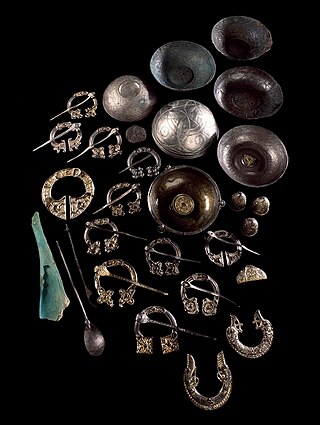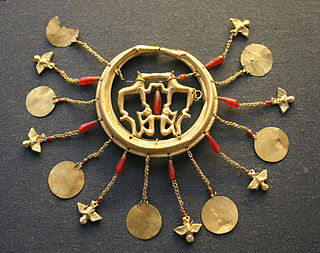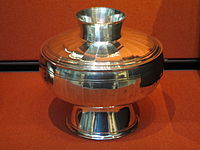
The Mildenhall Treasure is a large hoard of 34 masterpieces of Roman silver tableware from the fourth century AD, and by far the most valuable Roman objects artistically and by weight of bullion in Britain. It was found at West Row, near Mildenhall, Suffolk, in 1942. It consists of over thirty items and includes the Great Dish which weighs over 8 kg (18 lb).

Tableware is any dish or dishware used for setting a table, serving food, and dining. It includes cutlery, glassware, serving dishes, and other items for practical as well as decorative purposes. The quality, nature, variety and number of objects varies according to culture, religion, number of diners, cuisine and occasion. For example, Middle Eastern, Indian or Polynesian food culture and cuisine sometimes limits tableware to serving dishes, using bread or leaves as individual plates, and not infrequently without use of cutlery. Special occasions are usually reflected in higher quality tableware.


The Water Newton Treasure is a hoard of fourth-century Roman silver, discovered near the location of the Roman town of Durobrivae at Water Newton in the English county of Cambridgeshire in 1975. The hoard consisted of 27 silver items and one small gold plaque. Because of inscriptions found on some of the pieces in the collection it has been suggested that they may have been used in a local church, and they therefore comprise the earliest probable group of Christian liturgical silver yet found in the Roman Empire.

The Broighter Gold or more correctly, the Broighter Hoard, is a hoard of gold artefacts from the Iron Age of the 1st century BC that were found in 1896 by Tom Nicholl and James Morrow on farmland near Limavady, Ireland. The hoard includes a 7-inch-long (18 cm) gold boat, a gold torc and bowl and some other jewellery.

The St Ninian's Isle Treasure, found on St Ninian's Isle, Scotland in 1958 is the best example of surviving silver metalwork from the Early Medieval period in Scotland. The 28-piece hoard includes various silver metalwork items, including twelve pennanular brooches. The treasure is now in the National Museum of Scotland.

The Esquiline Treasure is an ancient Roman silver treasure that was found in 1793 on the Esquiline Hill in Rome. The hoard is considered an important example of late antique silver work from the 4th century AD, probably about 380 for the major pieces. Since 1866, 57 objects, representing the great majority of the treasure, have been in the British Museum.

The Chaourse Treasure is a hoard of Roman silver found in Chaourse, a village near Montcornet, Aisne in northern France in 1883. Dating between the 2nd and 3rd centuries AD, the treasure is one of the most complete table services to survive from antiquity. This important hoard is now part of the British Museum's collection.

The Aegina Treasure or Aigina Treasure is an important Minoan gold hoard said to have been found on the island of Aegina, Greece. Since 1892, it has been part of the British Museum's collection. It is one of the most important groups of Minoan jewellery.

The Lampsacus Treasure or Lapseki Treasure is the name of an important early Byzantine silver hoard found near the town of Lapseki in modern-day Turkey. Most of the hoard is now in the British Museum's collection, although a few items can be found in museums in Paris and Istanbul too.

The Beaurains Treasure is the name of an important Roman hoard found in Beaurains, a suburb of the city of Arras, northern France in 1922. Soon after its discovery, much of the treasure was dispersed, to be sold on the antiquities market. The largest portion of the hoard can be found in the local museum in Arras and in the British Museum.

The Domagnano Treasure is an important Ostrogothic hoard found at Domagnano, Republic of San Marino in the late nineteenth century. The treasure is now divided among various institutions, including the Louvre Abu Dhabi, although the bulk of the hoard is currently held by the British Museum in London and the Germanisches Nationalmuseum in Nuremberg.

The Canterbury Treasure is an important late Roman silver hoard found in the city of Canterbury, Kent, south-east England, ancient Durovernum Cantiacorum, in 1962, and now in the Roman Museum, Canterbury, Kent. Copies of the main items are also kept in the British Museum.

The Bursa Treasure or Brusa Treasure is the name of an early Roman silver hoard found in the city of Bursa, Turkey. Since 1913, the entire treasure has been at the British Museum.

The Boscoreale Treasure is a large collection of exquisite silver and gold Roman objects discovered in the ruins of the ancient Villa della Pisanella at Boscoreale, near Pompeii, southern Italy. Consisting of over a hundred pieces of silverware, as well as gold coins and jewellery, it is now mostly kept at the Louvre Museum in Paris, although parts of the treasure can also be found at the British Museum.
The Traprain Law treasure is a hoard of late Roman hacksilver, found on the hillfort of Traprain Law during excavations in 1919. It is the largest hoard of Roman hacksilver currently known, weighing just over 23 kg. It consists mostly of Roman silver vessels, a few of which are complete but most of which had been cut into fragments or crushed. There are a few items of personal equipment and coins. The hoard was probably buried in the early fifth century AD. Early interpretations saw it as loot; more recent views prefer to see it as diplomatic gifts or payment for military service. It is currently on display in the National Museum of Scotland in Edinburgh.
























